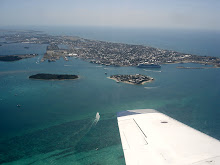
The city encompasses
Key West the namesake island, the part of Stock Island north of U.S. 1 (the Overseas Highway) (east), Sigsbee Park (north, originally known as Dredgers Key), Fleming Key (north), and Sunset Key (west, originally known as Tank Island). Nearby Key Haven (northeast), the part of Stock Island south of U.S. 1 (east), and Wisteria Island, better known as Christmas Tree Island (northwest), are in unincorporated Monroe County. Both Fleming Key and Sigsbee Park are part of the NAS Key West and are inaccessible by civilians.
Key West is the county seat of Monroe County.
Key West is known as the southernmost city in the Continental United States. It is also the southern terminus of U.S. 1, State Road A1A, and the East Coast Greenway.
Key West is 129 miles (207 km) southwest (229.9
degrees) of Miami, Florida, (about 160 driving miles) and 106 miles (170 km) north-northeast (21.2 degrees) of Havana, Cuba. Cuba, at its closest point, is 94 statute (81 nautical) miles south.
Key West is a seaport destination for many passenger cruise ships. The Key West International Airport provides airline service. Hotels and guest houses are available for lodging.
Naval Air Station Key West is an important year round training site for naval aviation due to the superb weather conditions. It is also a reason the city was chosen as the Winter White House of President Harry S. Truman.
The central business district primarily comprises Duval Street, and includes much of the northwest corner of the island along Whitehead, Simonton, Front, Greene, Caroline, and Eaton Streets and Truman Avenue.
The official city motto is "One Human Family."
Cayo Hueso (pronounced [ˈkaʎoˈweso]) is the original Spanish name for the island of Key West. Spanish-speaking people today also use the term Cayo Hueso when referring to Key West. It literally means "bone key". It is said that the island was littered with the remains (bones) from an Indian battlefield or burial ground. The most widely accepted theory of how the name changed to Key West is that it is a false-friend anglicization of the word, on the ground that the word "hueso" (pronounced [ˈweso]) sounds as if it could mean "west" in English. Other theories of how the island was named are that the name indicated that it was the westernmost Key, or that the island was the westernmost Key with a reliable supply of water. Many businesses on the island use the name, such as Casa Cayo Hueso, Cayo Hueso Resorts, Cayo Hueso Consultants, Cayo Hueso y Habana Historeum, etc. In 1763, when Great Britain took control of Florida, the community of Spaniards and Native Americans were moved to Havana. Florida returned to Spanish control 20 years later, but there was no official resettlement of the island. Informally the island was used by fishermen from Cuba and from the British Bahamas, who were later joined by others from the United States after the latter nation's independence. While claimed by Spain, no nation exercised de facto control over the community there for some time.
Conchs
Many of the residents of Key West were immigrants from the Bahamas, known as Conchs (pronounced 'conks'), who arrived in increasing numbers after 1830. Many were sons and daughters of Loyalists who fled to the nearest Crown soil during the American Revolution. In the 20th century many residents of Key West started referring to themselves as "Conchs", and the term is now generally applied to all residents of Key West. Some residents use the term "Conch" to refer to a person born in Key West, while the term "Freshwater Conch" refers to a resident not born in Key West but who has lived in Key West for seven years or more. However, the true original meaning of Conch applies only to someone with European ancestry who immigrated from the Bahamas. It is said that when a baby was born, the family would put a conch shell on a pole in front of their home.
Many of the Bahamian immigrants live in an area of Old Town next to the Truman Annex called "Bahama Village."
Major industries in Key West in the early 19th century included fishing, salt production, and salvage. In 1860 wrecking made Key West the largest and richest city in Florida and the wealthiest town per capita in the U.S. A number of the inhabitants worked salvaging shipwrecks from nearby Florida reefs, and the town was noted for the unusually high concentration of fine furniture and chandeliers that the locals used in their own homes after salvaging them from wrecks.


No comments:
Post a Comment